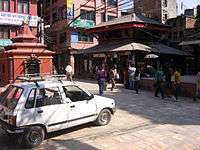Sthapit

Sthāpit (Devanagari: स्थापित) is a Nepalese caste from the Newa people of the Kathmandu Valley in Nepal. Sthapits are part of the Uray group which includes Tuladhar, Kansakar, Tamrakar, Bania, Sindurakar, Selalik and other castes.[1] Their religion is Newar Buddhism[2] and their mother tongue is Nepal Bhasa.[3]
Traditional Sthapit neighborhoods in Kathmandu are Thaymaru, Bhindyah, Makhan, Mikhadwan and Lagan. Makhan contains the largest population of Sthapits.[4][5]
Traditional occupation
Sthapit means "establish" in Sanskrit, and their traditional occupation, as per the division of labor laid down from ancient times, has been carpentry, architecture and engineering. They were skilled artisans, and were engaged in designing and building palaces, houses, temples and machinery.
Among the notable names, Jogbir Sthapit (alternative names: Joglal Sthapit, Bhajuman) was the architect who built Narayanhiti Palace in Kathmandu, the palace of the Shah dynasty, in 1886.[6][7] He was also the chief architect of the restoration project of Swayambhu which was completed in 1921.[8]
Cultural life
Like other Newar Buddhists, Sthapits mark the holy month of Gunla by making daily pilgrimages to Swayambhu playing Gunla Bajan music. Gunla is the tenth month in the Nepal Sambat calendar which corresponds to August. During the Bahidyah Bwayegu (बहीद्यः ब्वयेगु) festival which is one of the major events of Gunla, devotees led by a Gunla Bajan band make a tour of sacred courtyards in Kathmandu where statues of Dipankara Buddha and paubhas are put on exhibition.
During the Buddhist festival of Samyak, each Uray group has a task assigned to it by tradition, and Sthapits build the wooden viewing stand.[9] Samyak is the greatest Newar Buddhist ceremony in which large images of Dipankara Buddha are exhibited at Kathmandu Durbar Square and Swayambhu. It is held once every 12 years in Kathmandu.[10]
Notable Sthapits
- Jogbir Sthapit (1838-1926), architect who designed Narayanhiti and Seto Durbar palaces and supervised restoration of Swayambhu in 1918.
- Nirgun Sthapit (1968-1990), martyr of 1990 People's Movement.
- Sanu Sthapit, mechanical engineer who built a small goods train in Kathmandu.
- Sanu Ratna Sthapit (1928-2010), philanthropist, trader and pioneer hotelier.[11][12]
References
- ↑ Lewis, Todd T. (January 1996). "Notes on the Uray and the Modernization of Newar Buddhism" (PDF). Contributions to Nepalese Studies. Retrieved 26 September 2012. Page 110.
- ↑ Locke, John K. (2008). "Unique Features of Newar Buddhism". Nagarjuna Institute of Exact Methods. Retrieved 26 September 2012.
- ↑ Lewis, Todd T. "Buddhism, Himalayan Trade, and Newar Merchants". Retrieved 26 September 2012.
- ↑ Sthapit, Rajendra and Sthapit, Anil (eds.) (2012). Souvenir. Kathmandu: Sthapit Society. Pages 43-52.
- ↑ Tuladhar, Suman Kamal (coordinator) (2012). Udaaya Research. Kathmandu: Udaaya Samaj. Page 15.
- ↑ Dixit, Kunda (25–31 October 2002). "Dynasty". Nepali Times. Retrieved 28 October 2012.
- ↑ Ranjit, Sushmita (November–December 2009). "A thought over Narayanhiti Palace". Spaces. Retrieved 26 September 2012.
- ↑ Shakya, Hem Raj. (2004) Sri Svayambhu Mahacaitya. Kathmandu: Svayambhu Vikash Mandala. ISBN 99933-864-0-5. Pages 315-319.
- ↑ Gellner, David N. and Quigley, Declan (1995). Contested hierarchies: a collaborative ethnography of caste among the Newars of the Kathmandu Valley, Nepal. Clarendon Press. ISBN 0198279604, 9780198279600. Page 52.
- ↑ Lewis, Todd T. (1995). "Buddhist Merchants in Kathmandu: The Asan Twah Market and Uray Social Organization" (PDF). Contested Hierarchies. Oxford: Clarendon Press. Retrieved 26 September 2012. Page 47.
- ↑ LeVine, Sarah and Gellner, David N. (2005) Rebuilding Buddhism: The Theravada Movement in Twentieth-Century Nepal. Harvard University Press. ISBN 978-0-674-01908-9. Page 337. Retrieved 28 September 2012.
- ↑ Tuladhar, Lochan Tara (23 October 2010). "Dibangat Upasak Sanu Ratna Sthapit..." (PDF). The Dharmakirti. Retrieved 28 September 2012. Page 13.